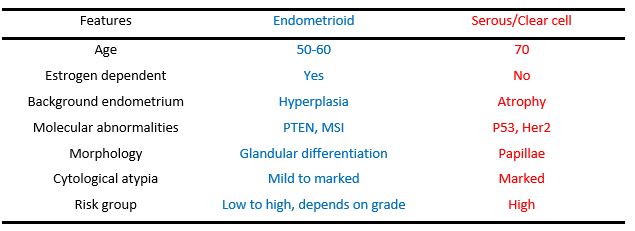Endometrial adenocarcinoma
Endometrial adenocarcinoma
Updated: 11/03/2023
© Jun Wang, MD, PhD
General features
- Most common gynecologic malignancy in US
- Incidence increasing
- More common in postmenopausal women
- Associated with complex endometrial hyperplasia, diabetes, dysfunctional uterine bleeding, hypertension, infertility, Muir-Torre syndrome, obesity, prolonged estrogen use, tamoxifen use
- Endometrioid type most common, followed by serous type
- May be part of Lynch Syndrome
Pathogenesis
- Prolonged estrogenic stimulation with reduced progestational activity if endometrioid
Clinical presentations
- Uterine bleeding
Classification
- Type 1: Endometrioid endometrial adenocarcinoma
- Type 2: Serous carcinoma, Clear cell carcinoma
Molecular changes
- PTEN: type 1, Endometrioid endometrial adenocarcinoma
- P53: type 2, Serous carcinoma, Clear cell carcinoma
Risk groups
- Defined by stage, pathological features, etc
- Low-risk: Grade 1 endometrial cancer of endometrioid histology that is confined to the endometrium. Very low recurrence following surgical treatment
- Intermediate-risk: Uterine-limited cancer with myometrium or occult cervical stromal involvement, higher risk of recurrence
- High-risk: stage III or higher endometrial cancer, regardless of histology or grade; or any stage of serous carcinoma or clear cell carcinoma, high risk of relapse and death
Treatment
- Surgery
- Radiation therapy
- Chemotherapy
- Hormonal therapy
Back to contents

Comments
Post a Comment